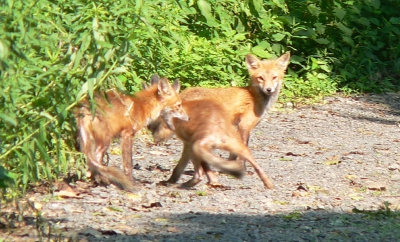 |
We assumed these foxes were raising a family in the long-abandoned gravel quarry on
our property. We finally got photos of three of the family. This proved to be more of a
challenge because the
adult foxes are more skittish when their kits are around. In this photo, even ignoring the still
apparent size difference, you can tell which is the adult. She (or he?) is watching attentively,
while the kits act
like children of all kinds, oblivious to possible dangers in their surroundings. The kits stay close
to the adult, who stays close to the safety provided by the undergrowth off to the side of the
driveway. For this photo, I was perhaps 15-20 m away and couldn't get closer. |
Now we regularly see Fox2 on our driveway and yard, especially late in the afternoon, and can approach to within just a few meters.
We talk to it (yes, really) and it mostly just observes us and goes about its business when it's ready.
 |
More recently, we speculated that the mysterious disappearance of goldfish from the small pond on our
front walk had an obvious explanation. On June 29th, near dusk, I took this photo through a glass pane
in our front doorway. The interior door was open, with only the screen door between us and Fox2 about 3
meters away. Laura and I were both standing there, and
one of our (indoor only) cats was clawing the screen. Fox2 was unconcerned and
lapped water from the pond for a couple of minutes before trotting off through the flower beds. We think
this observation solves the goldfish disappearance mystery. |
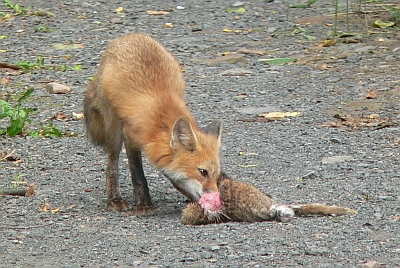 |
Resident foxes do not please everyone in our relatively rural township. Foxes are wily and
persistent predators
with a reputed fondness for chickens. However, from what I have read online, evidence suggests that foxes
prefer rodents even
when chickens are available. Around our house, we are pleased that they help control the population of
rabbits (as in this photo) and mice. Although foxes are certainly cute, this photo serves as a reminder that they are
wild animals with a job to do! |
We would like to claim credit for maintaining our property in a condition that foxes
find acceptable. However, all we have done is leave most of our three acres untouched.
We assume that the abandoned quarry, rocky and now
overgrown, provides lots of choices for den sites and plenty of hunting opportunities. We haven't
looked for the den, which would be nearly impossible this time of year and, in any event, we believe
the foxes will be more likely to stay if we don't bother them there.
In any case, we look forward to a long relationship
with this particular family.
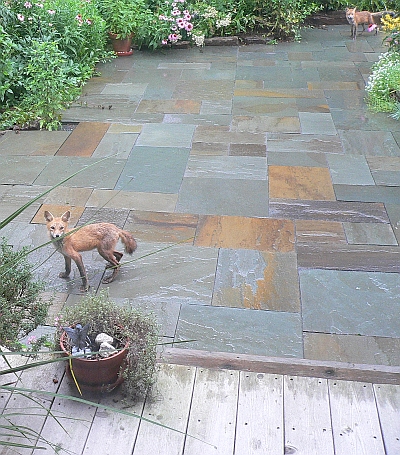 Notes from 5 July. My earlier common-sense warning about not touching foxes or their stool came into
sharper focus this morning, when Laura found Fox2 asleep out of the rain on our front doorstep, being nuzzled by one
of the kits ("Wake up, Mom, it's time for breakfast!") By the time Laura got this picture, they had
moved, looking more than a little offended. Why were they there? We have had an enormous
amount of rain over the last few days and it's possible their den was flooded. For whatever the
reason, this behavior may reinforce the belief that
foxes can be pets
-- independent and a little wild, but still easily approachable and friendly (sort of the canine version
of a house cat). This is not true!
Notes from 5 July. My earlier common-sense warning about not touching foxes or their stool came into
sharper focus this morning, when Laura found Fox2 asleep out of the rain on our front doorstep, being nuzzled by one
of the kits ("Wake up, Mom, it's time for breakfast!") By the time Laura got this picture, they had
moved, looking more than a little offended. Why were they there? We have had an enormous
amount of rain over the last few days and it's possible their den was flooded. For whatever the
reason, this behavior may reinforce the belief that
foxes can be pets
-- independent and a little wild, but still easily approachable and friendly (sort of the canine version
of a house cat). This is not true!
Also, this fox family has left an amazing
amount of stool on our driveway and flagstoned front walk. It is sticky and unattractive and begs to
be moved. I don't know
if anybody would be tempted to pick it up (I certainly wouldn't!), but use a shovel!
Update, 15 October, 2006.
How I acquired my very own personal fox.
Since the end of the summer, we have only rarely seen a fox, occasionally sunning itself in mid-morning
on our
driveway. It is one of the kits from the summer -- judging by its tail, the one
at the top of the last
photo above, standing in the background. When the fox family was more evident, hunting, doing cute things, and
playing on our property, they were "our" family foxes. Now, the weather has turned a little chilly and
a fox's thoughts turn to finding a sheltered and cozy spot to sleep. So, this morning, when fox poop
appeared on our front doorstep, Susan announced that this was now "my" very own personal fox.
Photography notes: These photos were taken with a handheld Panasonic DMC-FZ20 digital camera with 12X optical
zoom and automatic image stabilization. I have applied no digital processing other than cropping
some of the images and using the
"sharpen" feature in my image editing software.
I end this page with
what I hope is no more than a simple common-sense warning: Do not touch
foxes, alive or dead, or fox stool, with your bare hands! Foxes and related
animals may be infected with a parasite that can be transmitted to humans and can sometimes be fatal.
Be
careful
around pets who may have come in contact with foxes or their stool. See this
CDC Web site for Alveolar Echinococcosis for more information.
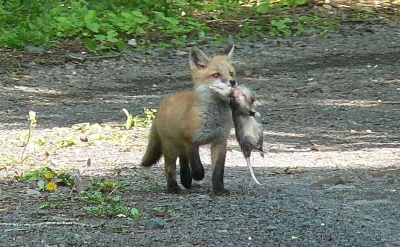 One morning in mid-May 2006, Susan was leaving for a meeting
and spooked a fox crossing our driveway,
carrying a dead young oppossum. It dropped its prey and scurried off into the woods. When Susan
came back
to the
house to report this sighting, we concluded that the fox was unlikely to abandon
this substantial meal. I picked up my camera and got into position. In only a couple of minutes, the fox
returned, and I snapped this picture.
One morning in mid-May 2006, Susan was leaving for a meeting
and spooked a fox crossing our driveway,
carrying a dead young oppossum. It dropped its prey and scurried off into the woods. When Susan
came back
to the
house to report this sighting, we concluded that the fox was unlikely to abandon
this substantial meal. I picked up my camera and got into position. In only a couple of minutes, the fox
returned, and I snapped this picture.

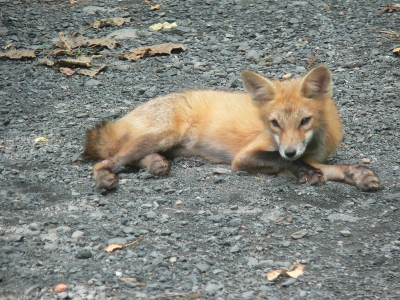
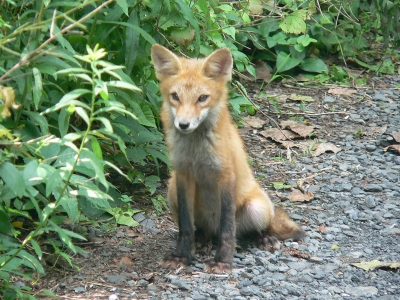



 Notes from 5 July. My earlier common-sense warning about not touching foxes or their stool came into
sharper focus this morning, when Laura found Fox2 asleep out of the rain on our front doorstep, being nuzzled by one
of the kits ("Wake up, Mom, it's time for breakfast!") By the time Laura got this picture, they had
moved, looking more than a little offended. Why were they there? We have had an enormous
amount of rain over the last few days and it's possible their den was flooded. For whatever the
reason, this behavior may reinforce the belief that
foxes can be pets
-- independent and a little wild, but still easily approachable and friendly (sort of the canine version
of a house cat). This is not true!
Notes from 5 July. My earlier common-sense warning about not touching foxes or their stool came into
sharper focus this morning, when Laura found Fox2 asleep out of the rain on our front doorstep, being nuzzled by one
of the kits ("Wake up, Mom, it's time for breakfast!") By the time Laura got this picture, they had
moved, looking more than a little offended. Why were they there? We have had an enormous
amount of rain over the last few days and it's possible their den was flooded. For whatever the
reason, this behavior may reinforce the belief that
foxes can be pets
-- independent and a little wild, but still easily approachable and friendly (sort of the canine version
of a house cat). This is not true!